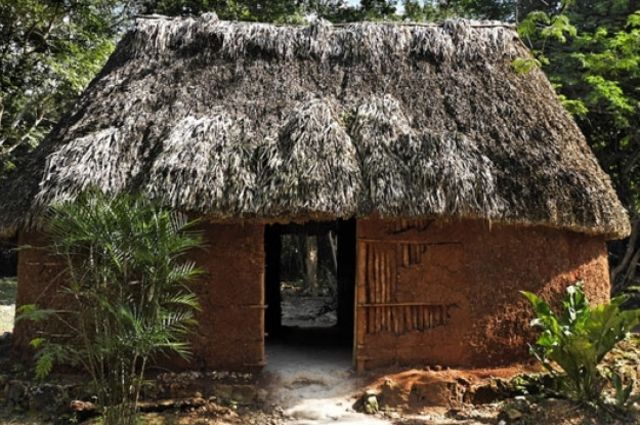The Maya regarded death as a natural occurrence. As soon as an individual died he was wrapped in a shroud, and to prevent his going hungry in the next life, ground corn dough was placed in his mouth. In his grave he was surrounded by offerings that showed his social rank, profession and sex, as well as his belongings.

If it was a warrior, his weapons were placed beside him; if it was a priest, his holy books and the beads used for predicting the future; if it was a woman, her stones for milling maize and her weaving tools. Also, a dog was buried to guide its master”s Pixan on the hazardous trip to eternity.
By day the bereaved mourned their departed one in silence and at night with cries and lamentations. The crossing from life to death was a difficult and delicate matter. It was believed that the souls of the dead did not leave the world immediately on dying.
They remained among their relatives
Carrying on their normal life unaware of their altered condition. Realization of what had happened came some days later and only then did the soul undertake its journey to the appointed place. This trance lasted longer with the soul of adults, which were unwilling to leave their bodies for fear of the Okol Pixan, or thieves of souls who prowled around during the final moments; this danger could be avoided through the presence of an Aj K iin to aid the dying person by placing him under the protection of Junab K uj.
When death throes were too prolonged, a relative would give the deceased twelve mild blows with a rope to ease the departure of the soul, which, detached from the body, would leave the house through the small openings at the ends of the jo olnaj- che or main beam.
Dead commoners or people without rank were buried under the floors or at the back of their houses, which were then abandoned by the relatives. Lords and governors, on the other hand, were buried in beautiful tombs-some of them of the most exquisite architectural artistry-on whose walls the stories of dynasties and divine lineages were told in painting and sculpture.
Their faces were covered with masks of jade mosaic
A asymbol of plenty and life. Nobles warriors and the socially prestigious priests were cremated and their ashes deposited in earthenware urns in the form of pots or figurines. Or sometimes the head was removed for veneration. It was boiled, scalped and split in two, cutting from side to side. The front was painted with bitumen or the features of the deceased were modelled in the empty spaces, and it was decorated with precious stones. These skulls were preserved on the family altars, whose design represented the form of the Universe.
¿Te ha gustado? ¡Comparte!
Si este artículo te parece digno y valioso para compartir... ¡Hazlo ahora!
Publicaciones relacionadas
El Alux come galletas leyenda Maya
La niña le daba galletas porque el alux se lo pedía. Don Humberto vivía en Telchac Puerto y era dueño de un terreno en Sinanche había una casa con muchos árboles frutales ahí acostumbraban a ir los fines de semana, para regar las
Un maya rescata a su mujer del Uay-Pach
Un monstruo gigante, verde que de su boca sale tres lenguas como cuchillas se robo a una mujer y el campesino trata de recuperarla. Este joven ha sido despojado de la mujer que ama, por el monstruo UAY-PACH, este muchacho a de recorrer
Cecilio Chi lider indígena Maya
Un lider que se distinguió por su lucha en defensa de los mayas. participó en una rebelión en contra del maltrato y explotación de los criollos. la rebelión se nombró "Guerra de Castas". Cecilio Chí, líder indígena maya, nació
Alimenta a un monstruo leyenda maya
La serpiente fue castigada por su arrogancia. Se cuenta que en el pueblo de Maní Yucatán cerca de Uxmal en una cueva donde hay un rio subterráneo, vive una bruja que cuida al reptil con mucho recelo y se cuenta que guarda el secreto de
El Walampach (leyenda maya)
En los pueblos remotos de Yucatán se cuenta de un fantasma tan alto, como un poste de luz. El Walampach, era negro, apenas se podía ver en la noche sus largos miembros y su horrorosa cabeza.Él camina por la calle, cuando sabe que hay
La soga que sangra, leyenda Maya
Dicen que existe una soga que está encerrada en una pesada caja de piedra en Uxmal, un día los hombres de campo la oyeron y la sacaron de la caja, se dieron cuenta que estaba demasiado larga que cuando intentaron ponerla otra vez la
Las Cabañuelas (tradición maya)
Las cabañuelas conocidas en maya como xook kiin, es un apoyo para los campesinos. sirveUn conglomerado de alteración del tiempo que hay en los primeros días de Enero que sirve para pronosticar el clima de cada uno de los meses del año.
Leyenda maya el Huay oso en Sucilá
Leyendas atrayentes que siguen vivas en la cultura maya. Huay en maya quiere decir, brujo, hechicero o curandero. Un hombre llamado Don Pedro Ku de 98 Abriles recuerda que hace muchos años en Sucilá, cuando empezaba la noche la gente
Hipil, prenda tradicional de la mujer maya
Esta hermosa prenda de vestir de la mujer maya comentaremos, sobre sus orígenes. Se definió la palabra huipil así; Los mayas hablantes de Quintana Roo llaman hipil a la indumentaria de la mujer maya, no Uipil o Uipilli, palabras de
Los Corcovados leyenda maya
Dicen que fue la primera etnía de los mayas, ellos alzaron los edificios mayas, que eran criaturas mágicas y que por donde caminaban crecían flores y plantas, eran nocturnos dominaban a las piedras con la mente. Venados